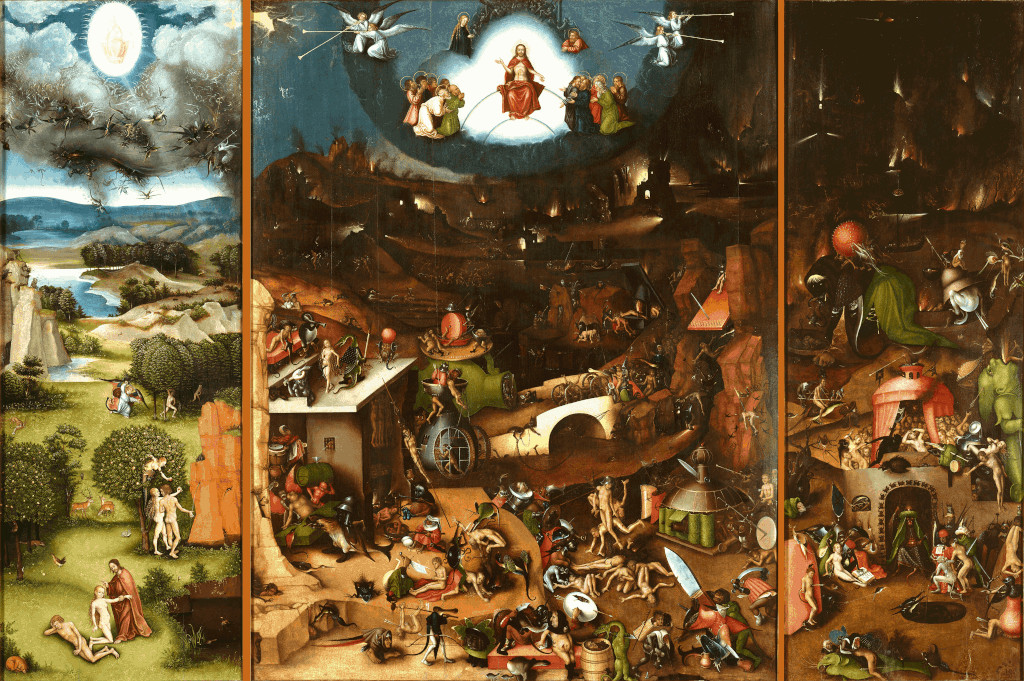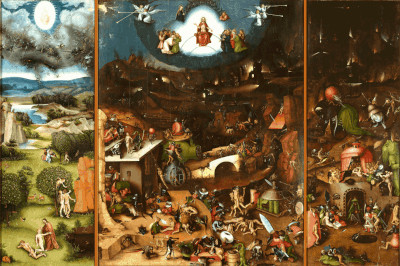The Last Judgement is a Hieronymus Bosch triptych from around 1482. The piece is today to be found at the Academy of Fine Arts in Vienna, Austria, but another version of the same name appears elsewhere.
Bosch's Triptychs
Those familiar with the triptych style of Bosch will not find any great surprises within this three-panel composition. He would take on many of the same themes elsewhere in his career, though it is likely that this interpretation came a little earlier than most of the others. As with many of the other triptych designs, we see the artist working left to right from one panel to the next, but also the story runs vertically downwards within each individual panel. This allows Bosch to feature several related stories within each section, before then explaining the consequences of them in the next piece. The obvious example within The Last Judgement is that we are told of the failures of man, before slowly progressing towards the ultimate punishment for these sins. The viewer is therefore entertained, but also warned about the consequences of their own behaviour, were it to diverge from the correct Christian path, as laid out in the Bible. The artist would make use of an experienced studio of assistants in order to deliver strong detail within each panel and so it is worth breaking each section down and discussing its own importance separately, whilst always keeping an eye on the overall scene being set by Bosch.
Background on the Artist
If you have had the chance to observe paintings by the inventive Dutch artist Hieronymus Bosch, you might have wondered what the incorporated scenes mean. One example of the paintings is the last judgement. The problem is that very little personal information is known about Bosch because he left no diaries or letters. Despite the date of his birth being unclear, he was born in 1450 in Netherlands. Bosch was widely known for his use of eye-catching imagery to illustrate religious and moral narratives and concepts. He is said to have derived his skills from his father and uncles who were also painters. The most famous work that was created by Hieronymus in 1504 is the Garden of Earthly Delights, a triptych that is also known as the last judgement. This is a painting that displays unique architecture and a burst of colours. In the artistic work, Bosch included weird creatures and an unusual landscape and you will also find religious aspects such as Adam, Eve, God and hell. Image interpreters say the agenda of the Last Judgement was to remind people that hell existed and they could be punished for eternity. He was said to be a genius of surrealism, a style of art that is not meant to be easily comprehended or understood.
Style of The Last Judgement
The key characteristic of the last judgement gives it a dreamlike quality. In it is a multitude of giant birds, nude humans, and horses cavort in a delightful landscape. Every element in the painting stands out to form a harmonious whole. The central panel of the portrait represents the seven deadly sins. On the left wing, you will notice the tumbling of the Rebel Angels, fall of man, creation of Eve and animals living with humans without interaction and expulsion. At the top in a bright area is God and on the right, the interior shows Hell. In the painting, the divine court is brought out as insignificant at the top, and only a few souls are numbered. The larger number of humans is seen to have been engulfed in the murky landscape below. The nightmare represents the earth as one destroyed by the fire foretold in the thirteenth-century hymn. Ideally, Bosch seems to have done very well creating artistic images of what the Garden of Eden, the return of Christ from the sky and Hell would be like. The Dutch painter who later died in 1516 at around the age of 65 left puzzling works that can be found in Vienna’s Picture Gallery at the academy of fine arts.
Analysis
The artist chose to depict scenes from the Garden of Eden to the left, and Hell to the right, just as with other panel series from his career. The Last Judgement then dominates the main central panel. Notice how the artist starts off on the left with space and bright colour, using tones of blue and green with figures dotted around the scene. This creates an atmostphere of health and nature, and sets the starting point for the narrative. At this stage, everything seems perfect, and if man has chosen the right path, then this scenario would have continued. Sadly, the stories within the first panel illustrate where things start to go wrong, and ultimately the judgement on man would be delivered in the next phase. The suffering brought about by this punishment is then shown in the final vertical piece, reminding the viewer of the importance of following the correct spiritual path. The closed wings reveal a grisaille artwork spread across the two panels, showing figures following the right path, literally, and the image of an aged man wandering by himself continues into other triptychs by this artist.
Meaning
As outlined in the analysis, all of Bosch's triptychs were intended to entertain and also to encourage the viewer to lead a moral life. He would work top-to-bottom and left-to-right across the inner panels, combining multiple passages from the Bible to outline where man went wrong, and what the consequences of their actions were to be. All of these topics were entirely typical of European art from the 15th and 16th century, but Bosch was able to deliver a stronger message than most because of his expressive artistic style and also the imaginative way in which he could bring these ideas to life. The legacy of his work is underlined by how several major artists would make their own copies of his work for their own pleasure, as well as for the purposes of understanding his technical work more clearly. Bosch's influence would also impact how other artists covered the same subject later on in the Renaissance, some years before the role of religion within western art started to fade. Many of Bosch's sprawling landscapes would include figures from different levels of society, reaching from the poorest peasants to leading religious representatives, purely in the hope that Bosch's message could impact as many people as possible and ensure that no-one believed they could live outside the will of God.
Location
The artwork has been in Austria for centuries and today resides at the Academy of Fine Arts in Vienna, Austria. It can be traced as far back as the mid-17th century when it was a part of the collection of the Archduke Leopold Wilhelm of Austria. Some historians have suggested that this piece was acquired by Philip I of Castile in 1504, which would help explain how it reached Austria, but this has been rejected by some other experts. We do also know that Lucas Cranach the Elder produced his own copy of the piece and that now resides within the Gemäldegalerie of Berlin. The low countries, in which Bosch was based, would come under the rule of different European kingdoms over a period of several centuries and this led to the dispersal of a number of famous artworks which have since made it into the collections of a number of notable art galleries and museums, just as with The Last Judgement.
Size and Medium
The Last Judgement by Hieronymus Bosch was produced using oils on wooden panels. As is typical for the triptych format, the wings are roughly the same size as the central panel, but half the width. This allows them to meet in the middle when closed, revealing an additional artwork which is spread across the two shutters. In order for the format to work correctly, the two wings are normally just a few centermetres longer than the main panel, and just a little less than half the width in order to allow for the frames. The left and right wing panels measure 167.7 cm in height by 60 cm in width and the centre panel measures 164 cm in height by 127 cm in width. Some of the artist's triptychs have been broken up into their individual panels, but thankfully this artwork remains in tact. Sadly, though, many efforts have been made to amend the paint work over a number of centuries which has somewhat damaged the artist's original work. The overall size of this artwork is fairly similar to the artist's other triptychs and hinges would be attached in order to allow the structure to be opened and closed.
The Last Judgement by Related Artists
This powerful theme has been used by artists from across the centuries. Whilst Bosch was busy producing two different triptychs on this topic, Michelangelo and a number of other artists from around the same period were doing the same in Italy. Michelangelo's Last Judgement sits on the altar wall of the Sistine Chapel and remains perhaps the most famous interpretation of all. Other notable contributions have come from Giotto (Giudizio Universale) as well as a woodcut engraving by Albrecht Durer. Most famous iterations came from these two European regions, which were at the forefront of the Renaissance in the 15th and 16th century. Most artists of this era would prominently display Christian themes within this oeuvres, with The Last Judgement being amongst the most common because of the powerful content that it could inspire and the strong moral messages that could be incorporated into each artwork. Bosch himself liked to make use of the three-panel approach in order to combine different stories together and lead the viewer into the final moment with a greater context already in their minds.
Large Image of The Last Judgement
It is impossible to appreciate a Bosch triptych without seeing them in person, but the next best option is one of the larger digital images that exist. We have included one below, but have also drilled down into the individual panels of The Last Judgement within a number of other pages which are linked to from this article. The higher resolution allows you to see the individual stories being played out as the narrative runs vertically down each panel. Some of the panels are quite dark in tone, making it hard to see much from a distance. Much of the fun with Bosch is in the detail, where he adds extraordinary creatures from the depths of his imagination and arranges them around man itself, creating new worlds which take biblical passages and extend them in ways that no-one else had thought of. Even today his individual artworks continue to be much loved and also researched in new ways, as historians hope to uncover new information on his groundbreaking and highly influential work from the 15th and 16th century.





